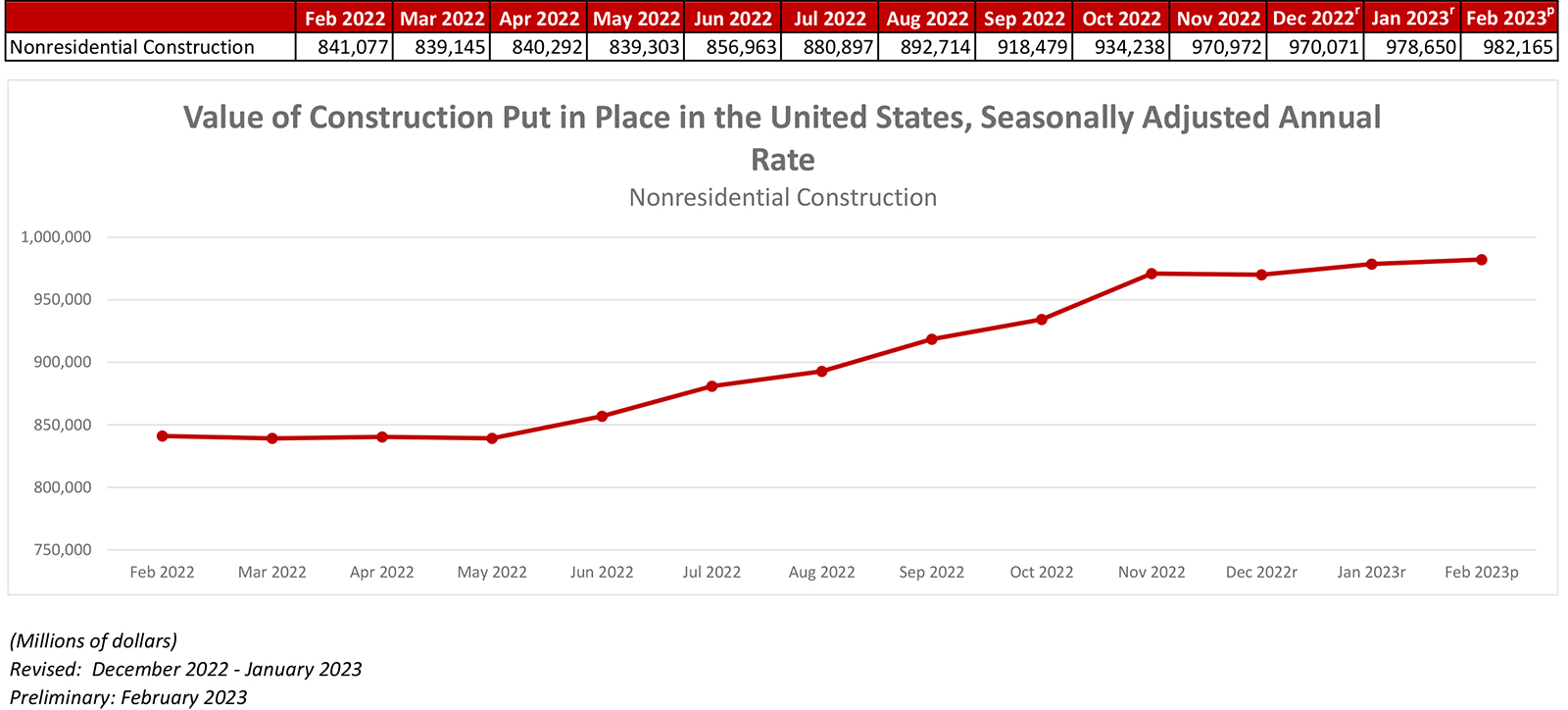
Key Takeaways
- National nonresidential construction spending increased by 0.7% in March.
- On a seasonally adjusted annualized basis, nonresidential spending totaled $997.1 billion for the month.
- "Given the surprising resilience of construction activity in the face of ongoing interest rate increases and pervasive fears of recession, this confidence has proved justified. Spending has increased over the past year in every nonresidential subsector except for the power category, and multifamily construction is up 23.0% over the past year."
Press Release from Associated Builders and Contractors: Nonresidential Construction Spending Increases By 0.7% in March, Says ABC
WASHINGTON, May 1—National nonresidential construction spending increased by 0.7% in March, according to an Associated Builders and Contractors analysis of data published today by the U.S. Census Bureau. On a seasonally adjusted annualized basis, nonresidential spending totaled $997.1 billion for the month.
Spending increased on a monthly basis in 8 of the 16 nonresidential subcategories. Private nonresidential spending rose 1.0%, while public nonresidential construction spending increased 0.2% in March.
“Nonresidential construction spending increased for the 10th time in the past 11 months,” said ABC Chief Economist Anirban Basu. “As has been the case for the past several months, though, the expansion in nonresidential investment is attributable to manufacturing. Were it not for a 4.6% increase in manufacturing-related spending, the nonresidential category would have been flat in March. Because this data is not adjusted for inflation, real nonresidential construction spending excluding manufacturing actually contracted in March.
“Contractors remain optimistic about their sales and profit margins over the next six months, according to ABC’s Construction Confidence Index,” said Basu. “Given the surprising resilience of construction activity in the face of ongoing interest rate increases and pervasive fears of recession, this confidence has proved justified. Spending has increased over the past year in every nonresidential subsector except for the power category, and multifamily construction is up 23.0% over the past year. The only construction category that is meaningfully affected by interest rate increases is single-family construction; spending is down 22.9% since March 2022.”
Press Release from Associated General Contractors of America: Construction Spending Inches Up In March As Big Boost In Manufacturing Activity Offsets Declines In Residential & Some Nonresidential Segments
Construction Officials Say Permitting Delays Appear to Be Holding Up Public Construction Activity, Warn that Firms Continue to Struggle to Find Enough Workers to Hire Amid Labor Shortages
WASHINGTON, May 1—Total construction spending increased by 0.3 percent in March as growth in manufacturing and education pulled up nonresidential construction spending for the month, according to an analysis by the Associated General Contractors of America today of new federal data. Association officials said the increases in construction demand were occurring during a time when most firms are struggling to find workers to hire.
“The manufacturing construction boom is really helping construction weather the softening residential and other nonresidential markets,” said Stephen E. Sandherr, the association’s chief executive officer. “But even as overall demand continues to increase, most firms are having a hard time finding enough workers to keep pace with that demand.”
Construction spending, not adjusted for inflation, totaled $1.834 trillion at a seasonally adjusted annual rate in March, 0.3 percent above the February rate, which was revised down from the initial estimate a month ago. Spending on private residential construction decreased for the tenth consecutive month in March, by 0.2 percent. Spending on private nonresidential construction increased by 1.0 percent in March, while public construction investment rose by 0.2 percent.
Spending varied among large private nonresidential segments. The biggest component, manufacturing plants, jumped 4.6 percent compared to February. Commercial construction—comprising warehouse, retail, and farm construction—decreased 0.8 percent for the month. Power construction dipped 0.3 percent while spending on private office construction, including data centers, rose 0.3 percent compared to February.
The largest public categories were mixed, as well. The biggest, highway and street construction, declined 0.1 percent for the month, while education construction grew 0.7 percent. Public spending on transportation projects fell 1.6 percent compared to February. Residential spending shrank due to a 0.8 percent contraction from March in single-family homebuilding. That outweighed an increase of 0.4 percent in multifamily construction for the same time frame.
Association officials attributed the lackluster infrastructure spending to the fact many now-funded projects are waiting for construction permits for activity to proceed. They urged Congress enact bipartisan permitting reforms to streamline bureaucratic reviews and curtail frivolous lawsuits aiming to delay or cancel projects. They also continued to urge federal officials to boost funding for construction training and education programs.
“The administration is beginning to realize that the permitting problems we have long warned about are real and holding up many of the projects they are eager to get started,” Sandherr said. “Streamlining the permitting process and investing in workforce development will open the spigot on projects and rebuild the talent pipeline for the workers to build that infrastructure.”













